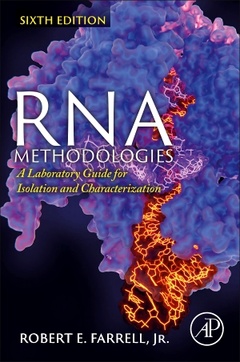Description
RNA Methodologies (6th Ed.)
A Laboratory Guide for Isolation and Characterization
Author: Farrell Jr. Robert E.
Language: English
Keywords
Gene expression; quantification; RT-PCR; transcriptomics; molecular biology; biochemistry; cloning; miRNA; RNA-seq; real time PCR; biomarker; disease; bio-molecular interactions; genome; proteome; transcription; DNA; biotechnology; bioinformatics; circular RNA; transcription; RNA polymerase; gene regulation; splicing; ribonuclease inhibitors; stringency; affinity matrices; RNA isolation; polyadenylation; magnetic bead technology; tissue; cell culture; homogenization methods; UV spectrophotometry
960 p. · 15.2x22.8 cm · Paperback
Description
/li>Contents
/li>Biography
/li>Comment
/li>
RNA Methodologies: A Laboratory Guide for Isolation and Characterization, Sixth Edition provides the most up-to-date ribonucleic acid lab techniques for seasoned scientists and graduate students alike. This edition features new material on RNA sequencing, RNA in Situ Hybridization, non-coding RNAs, computational RNA biology, transcriptomes and bioinformatics, along with the latest advances in methods and protocols across the field of RNA investigation. As a leader in the field, Dr. Farrell provides a wealth of knowledge on the topic of RNA biology while also giving readers helpful hints and troubleshooting techniques from his own personal experience in this subject area.
This book presents the essential knowledge and techniques to use when working with RNA for the experienced practitioner, while also aiding the beginner in fully understanding this important branch of molecular biology.
2. Creating a ribonuclease-free environment 000
3. Stringency: conditions that influence nucleic acid structure
4. Ribonucleic acid isolation strategies
5. Isolation of polyadenylated RNA
6. The truth about tissues
7. Going green: RNA and the molecular biology of plants
8. Quality control for RNA preparations
9. cDNA: a permanent biochemical record of the cell
10. RT-PCR: a science and an art form
11. Quantitative polymerase chain reaction techniques
12. miRNA and other noncoding RNAs
13. RNA interference and gene editing
14. Electrophoresis of RNA
15. Photodocumentation and image analysis
16. Northern analysis
17. Nucleic acid probe technology
18. Quantification of specific mRNAs by nuclease protection
19. Analysis of nuclear RNA
20. RNA in situ hybridization
21. Array analysis of gene expression
22. Subtractive and nonsubtractive methods for the analysis of gene expression
23. Transcriptomes and bioinformatics
24. RNA-seq: the premier transcriptomics tool
25. RNA biomarker discovery and validation
26. Functional genomics strategies
27. A few RNA success stories
Epilogue
Appendix A: Maintaining complete and accurate records
Appendix B: Converting mass to moles
Appendix C: Removal of DNA from an RNA sample
Appendix D: Removal of RNA from a DNA sample
Appendix E: Electrophoresis: principles, parameters, and safety
Appendix F: Disposal of ethidium bromide and SYBR Green solutions
Appendix G: Deionization of formamide, formaldehyde, and glyoxal
Appendix H: Silanizing centrifuge tubes and glassware
Appendix I: Centrifugation as a mainstream tool for the molecular biologist
Appendix J: Dot blot analysis
Appendix K: Useful stock solutions for the molecular biologist
Appendix L: Genomes and proteomes
Appendix M: Common SI prefixes
Appendix N: Common abbreviations
Appendix O: Select suppliers of equipment, reagents, and services
Appendix P: Trademark citations
Glossary
- Presents the latest information covering all aspects of working with RNA, delivering a holistic understanding of this leading field in molecular biology
- Builds from basic information on RNA techniques to in-depth protocols for specific applications
- Features new chapters on RNA sequencing and RNA in situ hybridization
- Includes new material on RNA clinical applications and innovations, including RNA therapeutics and RNA vaccines, with particular relevance to coronavirus
- Comprises the latest developments in transcriptomes and bioinformatics, with new material on computational RNA biology, RNA CHiP analysis, aptamer biology and RNA epigenetics




